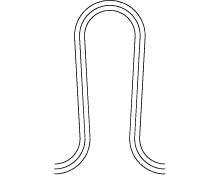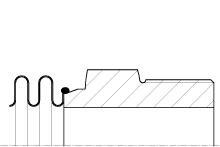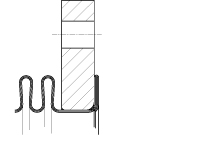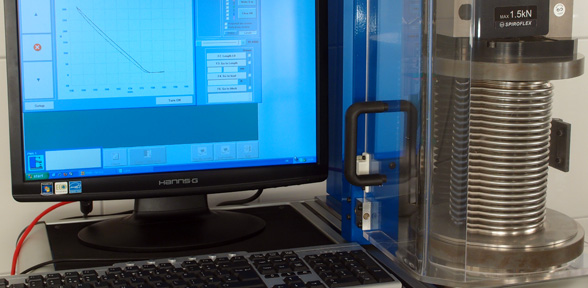Products
Contact us
Spiroflex d.o.o.
Ljudevita Gaja 7
35 208 Ruščica
Croatia
Phone: +385 35 212 425
e-mail: info@spiroflex.hr
Metal expansion joints
Technical Information
The expansion joints
Stainless steel expansion joints are special devices which compensate thermal pipe expansion or contraction and absorb equipment vibration or pipe motions.
Bellows is a basic part of expansion joint and it is made by forming metal cylinder into annular corrugations. The bellows can be single or multi-ply.
The bellows properties and their flexibility depend on shape of convolutions, thickness and number of plies. Convolution geometry and the above characteristics determine the pressure resistance, bellows spring rates and all kinds of movement absorption.

single ply

two plies

multi-ply
Materials for bellows and their temperature limits
| Materials | Temperature °C | ||||
| Type | EN 10027-2 | Steel name | USA AISI | min. | max. |
| Stainless austenitic steels | 1.4301 | X5CrNi18-10 | 304 | -196 | 550 |
| 1.4306 | X2CrNi19-11 | 304L | -270 | 550 | |
| 1.4401 | X5CrNiMo17-12-2 | 316 | -196 | 550 | |
| 1.4404 | X2CrNiMo17-12-2 | 316L | -270 | 550 | |
| 1.4435 | X5CrNiMo18-14-3 | -270 | 550 | ||
| 1.4541 | X6CrNiTi18-10 | 321 | -270 | 550 | |
| 1.4550 | X6CrNiNb18-10 | 347 | -196 | 550 | |
| 1.4571 | X6CrNiMoTi17-12-2 | 316Ti | -270 | 550 | |
| Heat resistant austenitic steels | 1.4828 | X15CrNiSi20-12 | 309 | -196 | 550 |
| 1.4876 | X10NiCrAlTi32-21 X10NiCrAlTi32-21 (H) |
Incoloy 800 | -196 | 600 (900) | |
| Nickel alloys | 2.4610 | NiMo16Cr16Ti | Hastelloy C4 | -196 | 400 |
| 2.4816 | NiCr15Fe | Inconel 600 | -10 (-270) | 450 (900) | |
| 2.4856 | NiCr22Mo9Nb | Inconel 625 | -196 (-270) | 450 (900) | |
| 2.4360 | NiCu30Fe | Monel 400 | -196 | 425 | |
| 2.4858 | NiCr21Mo | Incoloy 825 | -10 | 540 | |
Bellows materials
Spiroflex designs and manufactures bellows out of material that is kept on stock, or procures it as new contract is agreed, as follows.
The basic material for bellows manufacturing which generally satisfies demands for wide application e.g. cooling or heating systems. This material contains titanium which is used as stabilizing element, increases resistance to intercrystalline corrosion.
Normally used in heating systems, food and chemical industry, and also in exhaust systems. Just as by 1.4541 material, the titanium content increases resistance to intercrystalline corrosion, the addition on manganese increases resistance to pitting corrosion at media which contain chlorides.
Material with low carbon content (under 0,03%) and good resistance to intercrystalline corrosion. This material and 1.4571 are interchangeable and generally can be used for the same application.
Heat resistant austenitic steel for application at high temperatures and aggressive media. It has high resistance to corrosion and oxidation caused by high temperatures and it is ideal for applications where mechanical properties are important. It is used at furnace engineering and other high temperature applications.
Heat resisting high strength steel, resistant to oxidation and other damaging effects at high temperature exposure. General corrosion resistance is excellent. Suitable for temperatures of 600 (900) °C.
Nickel-chromium alloy for application at high temperatures and aggressive media. Resistant to chloride stress corrosion cracking, corrosion by high purity water, caustic corrosion. Used in chemical and food industry, nuclear engineering.
Material specially produced for application for bellows. Resistant to sea water, pitting and crevice corrosion. Used in chemical processing, marine and nuclear engineering, aerospace engineering etc.
Nickel-copper alloy with high resistance to sea water and steam at high temperatures, resistant in a range of acidic and alkaline environments. It is used in chemical industry, desalination, oil industry, marine engineering etc.
This is austenitic nickel-iron-chromium alloy with addition of molybdenum and copper. Very resistant to a variety of corrosion environments like: chloride pitting, stress corrosion cracking, intercrystalline corrosion and crevice corrosion. It is used in chemical, oil, gas industry, acid production, pollution control equipment etc.
Movements
The movement of bellows depends on convolution geometry and properties of materials used. The bellows from our production program absorb axial, lateral and angular movements.

Axial movement
Axial movement is the motion which occurs parallel to the bellows axis. This movement is generally expressed as compression or shortening and extension or elongation of bellows.

Lateral movement
Lateral movement is the motion perpendicular to the centerline of bellows. It is the ability of bellows to absorb lateral deflection of bellows.

Angular movement
Angular movement is the rotation or bending of a bellows element.
Connection components of expansion joints
The bellows – elastic part of expansion joints are welded or joined at connecting elements: pipe ends, flanges and threaded connections. The connecting pieces are welded by TIG, microplasma, MIG or MAG welding.

Connecting elements welded by TIG or microplasma procedure

Connecting elements welded by TIG or microplasma procedure

Connecting elements welded by TIG or microplasma procedure

Connecting elements welded by TIG, MIG or MAG procedure

Connecting elements welded by TIG, MIG or MAG procedure

Expansion joint with loose flange
Internal sleeves
Internal sleeves as protection for bellows should be specified for all expansion joints in the following cases:- If media contain abrasive material
- When it is necessary to hold friction at minimum and if smooth flow is desired
- When flow velocities are high and could produce resonant vibrations of the bellows, installation of internal sleeves is recommended in accordance to diagram below
- If turbulent flow is generated by changes in flows direction (valves, tee of elbow sections, pumps, T-pieces)

Criteria for determining the need for internal sleeve – for speeds above the curves internal sleeves should be used







